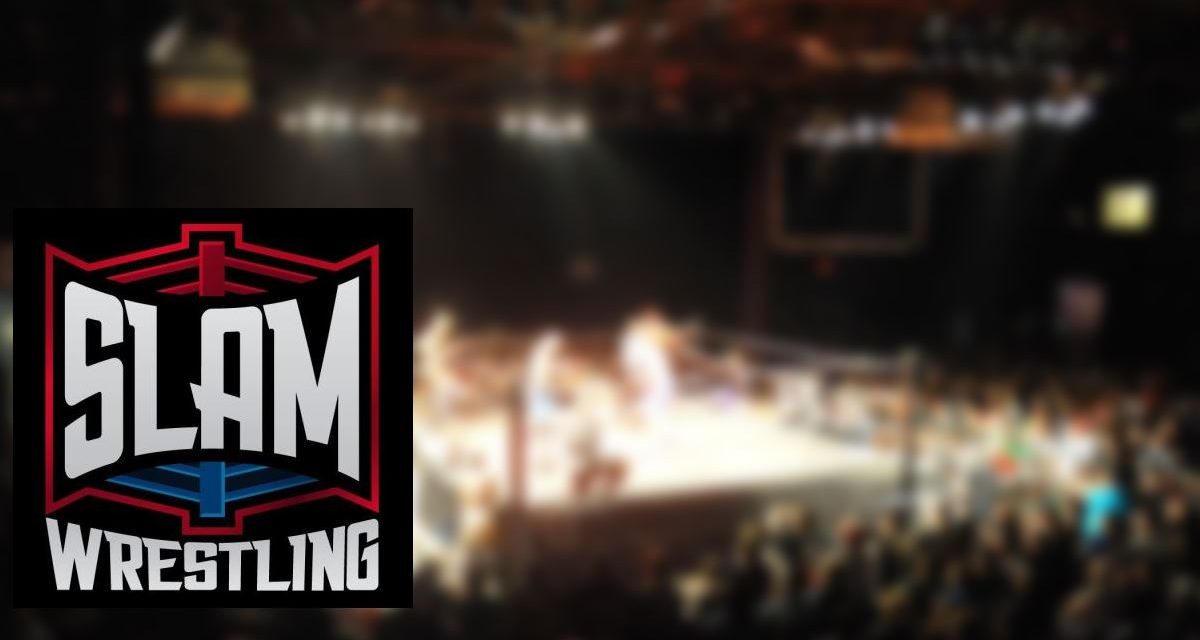He’s been called unknown and underrated, but for “Machine Gun” Karl Anderson, a gaijin star in New Japan Pro Wrestling, the best part is that he doesn’t have to worry about another “un” word: unemployment.
Anderson has been on a contract with NJPW since since March 2008, when he first traveled overseas on a three-month live-at-the-dojo deal, which paid a monthly guarantee that was at least better than what he was making on the independent wrestling scene.

“Machine Gun” Karl Anderson in his promo picture for New Japan Pro Wrestling
It was a leap of faith for Chad Allegra at that point, having already packed up and moved from his North Carolina home to Cincinnati to train as a pro wrestler and then to Los Angeles for a stint in the New Japan dojo there.
Working in Japan was something else. “I got to live there and train there for three months. After my first match, they asked me if I wanted a year contract right away. I said, ‘Yep,'” Allegra, 33, recalled for SLAM! Wrestling. “It just all came out of nowhere.”
And, in early February 2013, he re-upped with New Japan for another year, and proceeded to go out and main event against IWGP Heavyweight Champion Hiroshi Tanahashi, losing a hard-fought, 25-minute battle on the NJPW “The New Beginning” iPPV.
In Japan, the 6-foot, 240-pound Karl Anderson has progressed from a lower-mid-card wrestler, often putting over the Japanese regulars, to a comedic tag team wrestler that morphed into a successful pairing with Giant Bernard (Matt Bloom, now WWE’s Tensai), and now, to where his singles match with Shinsuke Nakamura from May 2012 was considered in the running for Match of the Year.
Four years ago, few would have thought that growth was possible.
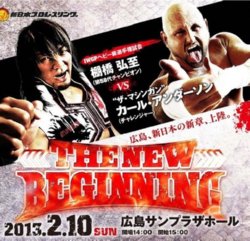
A headliner to start 2013.
“I would have thought it would have been possible in my own brain, but then I look back on those things and I realize that I guess I wasn’t ready. I wasn’t as progressed as I am now,” Allegra said. “Just everything comes with time. It just takes time and a lot of work, a lot of training, and just kind of understanding wrestling.”
Growing up, Allegra was a three-sport star at A.C. Reynolds High School near Asheville, N.C., excelling in baseball, football and basketball. Up next was Mars Hill College, in Mars Hill, N.C., from September 1998 to June 2000, where he played baseball.
In August 2000, Allegra packed up for Cincinnati, Ohio, and trained a little with Les Thatcher before settling in to learn the pro wrestling business under Roger Ruffin, who also taught Abyss, Jillian Hall and “Wildcat” Chris Harris.
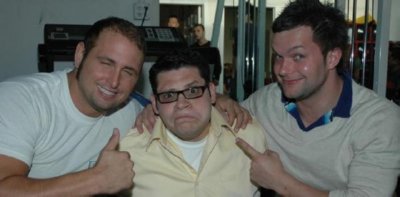
Karl Anderson, Dave Marquez and Fergal Devitt
During a NWA convention in Nashville, Tennessee, in June 2005, Allegra caught the eye of Los Angeles promoter David Marquez, who was a key figure with Inoki Sports Management, Inc., and its ties to New Japan.
Marquez thought that Allegra stood out on the card that weekend and believed he could be successful in Japan. An invitation to train at the L.A. New Japan dojo was offered.
“As predicted, he started to shine and within a few weeks I was trying to package him for Japan,” said Marquez. “What I saw in him was drive. Through the thickest of times, he always pushed and achieved his goals. I’m not going to say everyday was easy, it wasn’t. There was a lot of corporate mess going on in NJPW at that time and unfortunately it hit everyone, especially the dojo guys. I’m just happy he stuck with it and that he’s cemented himself with the Japanese public and it’s only a matter of time before North America discovers him … when he’s ready, we’ll know.”
There were a number of significant names that spent time at the New Japan L.A. dojo, including Fergal Devitt, Mikey Nicholls, Alex Kosloff, Rocky Romero, and Bryan Danielson. Devitt remains one of Allegra’s closest friends.
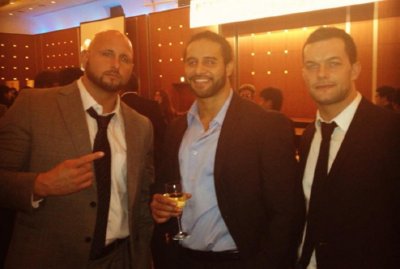
Karl Anderson, Tama Tonga and Fergal Devitt
Devitt weighed in, via email, on what makes his buddy a hit.
“Chad’s hard work, dedication and consistency is what has made him a success. Some people think you can become a great wrestler over night, but to be able to preform at the level Chad does night after night takes literally years of experience and hard work, and few have been through what Chad has been through to get to where he is today,” wrote Devitt. “In his own words, Chad is a ‘Bad motherf—er’ and it shines through in the ring, he gets in there and handles business. There is no funny business, it’s wrestling as it should be, and personally Chad is one of my favourite performers to not only watch but also to study.”
While based in L.A., Allegra teamed with Joey Ryan as the Real American Heroes, claiming the NWA World tag team titles, and worked for Pro Wrestling Guerilla.
In retrospect, the move to Los Angeles was the right one, but Allegra, who only had four years of weekend wrestling under his belt at the time, said he had a lot of misgivings.
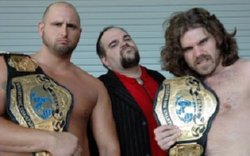
The Real American Heroes, Karl Anderson and Joey Ryan, centered by manager Vander Pyle.
“I actually hated my whole time in L.A. There were always great times, but I look back on it now, and I wasn’t happy there at all. I just didn’t enjoy myself. I was broke. Just the whole time sucked — except the bonds and the friendships that I made. That part was great,” he admitted. “But it was the right decision. That’s the young and immature thing, thinking that you should be on TV right away, which was kind of in my head. Not that I should have been on TV, but I just wanted something to happen, which a lot of wrestlers need to realize patience.”
It took two years and one name change before Allegra was invited to Japan.
“I knew his given name wouldn’t work and the Japanese loves nostalgia. Previously, we made Chad Collyer ‘Chad Malenko’ for a Japanese tour and I felt Allegra needed something similar,” recalled Marquez. “Since he is from the ‘South’ and has a kind of ‘twang’ in his voice, I felt he could be an ‘Anderson’ — something he wasn’t keen to. The Karl with a ‘K’ came about because of the other Andersons: Lars and Ole and to me he looked like an Anderson, so I went with it.”
It took time for Allegra to be comfortable with it. “I’m good with it now. I don’t particularly want to say that I’m part of the Anderson family, because that’s not real. That bothered me at first. I was just a no-name and they were trying to call me Karl Anderson. I was like, ‘Have you guys cleared this with anybody? Can you call Mr. Arn Anderson to ask if it’s okay?'”
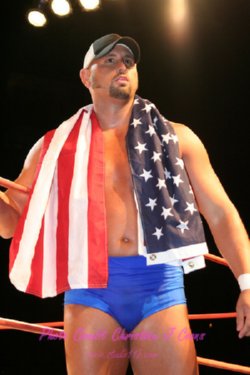
Karl Anderson, half of The Real American Heroes, at the NWA 60th anniversary show in Atlanta in June 2008. Photo by Christine Coons
Another life-long friend he made in L.A. was Shinsuke Nakamura, and they have paired off often since for some great matches, and some extra-curricular fun too.
“Me and Shin are exactly the same age and we hit it off right away. We were just hanging out and drinking beer and training every day,” said Allegra. “I think Shinsuke helped me out a lot in Los Angeles, just watching tapes together, watching YouTube, getting in the ring together and doing the natural wrestling that makes it look so real. I’d never had that kind of training before. In Cincinnati, I would wrestle in Kentucky or Indiana or something and it was just all about, you’d put a tackle on somebody and you’d look at the crowd and you’d tell them to shut up and they’d boo at you. It was simple, just different. So I wasn’t really used to getting on the mat and just wrestling around, just going with the feel of it. Going to that Los Angeles dojo helped a lot. Then when I finally went to New Japan, just wrestling every day with those guys, just wrestling that style, that natural stuff. Things just kind of progressed.”
In Japan, where the action has to look far more punishing and physical than the North American style, “Machine Gun” Anderson has excelled, shooting his finger weapons in the ring and delivering the rugged action. (“I hope people realize that it’s just entertainment. I’ve never even shot a real gun in my life. I grew up in North Carolina, but never went hunting.”)
It’s just that few people know that in North America.
“Karl Anderson is probably one of the most underrated, unknown guys that should be known in the business,” said Lance Archer (TNA’s Lance Hoyt, WWE’s Vance Archer) at the recent Hart Legacy Wrestling show in Calgary. “What he’s done in Japan has definitely set the tone of who he should be in the business in the future.”
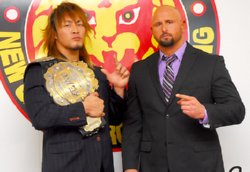
IWGP Heavyweight Champion Hiroshi Tanahashi and Karl Anderson. Photo courtesy New Japan Pro Wrestling.
Harry Smith had similar thoughts on Anderson, while sitting beside Archer. “I think that Karl’s a good performer in the ring. I think he’s one of the most, I don’t know, maybe underrated guys out there, but also unknown. But now that New Japan is becoming more worldwide, I think that he’ll start to become better known to the average fan. He’s got a very unique style. I really like his matches,” said the British Bulldog Jr. “Personally, I really like Karl. He’s my friend, but I’ve got to stop going out and having beers with him. He’s a bad influence and every time I go out with him it makes me hungover.”
“Wait, wait, wait! Karl Anderson makes Harry Smith hungover?” interrupted Archer. “I call bullsh– on that one.”
While Allegra admits to having a few beers with Smith, he stressed that he goes out with just about anyone on the New Japan roster to blow off some steam. Sometimes it’s darts with Tanahashi or beers with Shinsuke.
“They’re all my friends. They’ve all taken really good care of me,” he said. “It’s the kind of thing that people don’t see or know about, but they’re all good guys, man.”
For the longest time, Allegra’s buddy in Japan was Giant Bernard.
“We became really good friends, and he helped me a lot,” said Allegra. “He just got so over. He’s a smart guy; I don’t know if people realize how smart of a wrestling mind he has because of some of the gimmicks that he’s had through his career. When he finally went back to WWE recently, it was just a nice opportunity, a nice chance to see if I can step out on my own and make it happen, just get a chance to be a singles guy.”
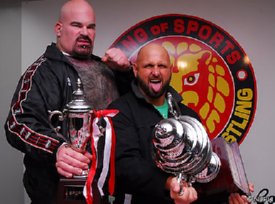
Bad Intentions — Giant Bernard and Karl Anderson. Photo courtesy New Japan Pro Wrestling.
With Giant Bernard towering over him (6-foot-8 to 6-even) and outweighing him (360 to 240), they made a visually different team, known as Bad Intentions, and held both the IWGP tag titles and GHC tag titles.
“We clicked and had a lot of chemistry. I think that helps a lot when you get along with somebody. I think the size difference was actually the cool thing about it because in the beginning, he would tag me in and I would just sell like his hand when it tagged hurt really bad; people loved that and thought it was funny,” said Allegra. “Then it progressed to where people actually believed I could team with him, that I actually was hanging with him. When they put us together at first, we were losing a lot and all the time, and then they finally gave us a little push and people started to believe us. We just clicked, never argued putting matches together. It was always real smooth. He was a cool cat.”
While hesitant to condemn WWE for dropping the ball with the Tensai character, Allegra is contemplative about jumping to the world’s biggest wrestling company should the chance present itself.
“Yeah, if the right opportunity came,” he said. “It would have to be the right opportunity, the right move, the right money, I guess. I don’t know. Everything would have to work out.”
For now, he is content to continue toiling in Japan.
“I’m happy to have done what I did,” he said. “I mean, nobody really knows about New Japan Pro Wrestling. I guess, why would they, because it’s not going to be on TV over here. The only way you’re going to see it is through YouTube or buying the iPPVs that they’re doing now also. Every now and then, if I’m in the airport going to Japan, I’ll get some Japanese fans who know who I am, or the rare occasion that a smart fan will be in an airport. But no, it definitely doesn’t bother me at all (to not be known).”
Devitt believes Allegra will be better known soon enough. “Chad is a star, and will be a star anywhere he goes, be it Japan right now, or perhaps North America in the future, every company on the planet could benefit from having who I consider one of — if not the best — all-round performers in wrestling right now.”
With the knowledge of how communications used to be, Allegra knows he is living in a smaller world anyway, and is able to talk with his two sons, both under three years of age, Caedon, and Cylus, through the wonders of Facetime or Skype.
“I think back on the guys in the ’80s or ’90s, the wrestlers that would be over in Japan for that amount of time, and I can’t imagine what that had to be like,” he said. “Do you send Polaroids of your kids through the mail just to see them? My second son just started walking while I was in Japan — of course that’s a big deal — but I got to see it on Facetime, which is pretty cool. If I hadn’t have been there, talking to him every couple of days, or once a week, and I come home and he’s walking, that would have been a big shock.”
His wife is able to stay home with the kids in their Cincinnati home, and, when he isn’t on tour, Allegra is right in there being Mr. Mom.
“I’ll wake up, feed my kids, I’ll watch some SportsCenter, I come to the gym, workout, go back home, play with the kids, watch some more SportsCenter, watch wrestling at night. That’s it,” he laughed.
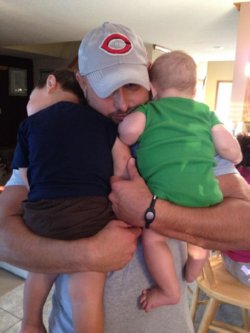
Karl Anderson, a.k.a. Mr. Mom.
The Japanese tours can last anywhere from a few days to six weeks. That can often mean three weeks or so straight in the U.S.
The plane travel is simply something he will never completely get used to.
“Luckily my status is so high now, I have Diamond Status on Delta that if it’s overbooked or whatever, I’ll get an upgrade, which is really nice,” Allegra said. “For me, it’s not something worth fighting over. The guys like Giant Bernard, they get First Class, but he’s also 6-foot-8.”
And the jet lag? Do you get used to that?
“People always ask me that and no, no way. You get used to dealing with it, I guess. When I come home, I’m absolutely wrecked, for two or three days, and if I don’t get any sleep those days, it can last up to a week.”
— with files from Jason Clevett
TALKING ABOUT A REVOLUTION
Allegra was a part of Jeffrey Katz’ ballyhooed Wrestling Revolution Project / Wrestling Retribution Project as Killshot. Like many fans, he is eager to see what, if anything, ever comes of it.
“I’m sure it’s going to happen at some point, but I thought it would have been released by now. I haven’t heard anything from Jeff about it or what’s coming next or anything. I thought it was good when I was there. It was kind of different, because it was in a small setting — it was just different. … I don’t know what to say about it because I don’t know what happened to it.”
